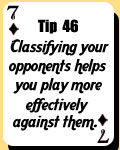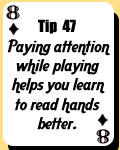Classifying your opponents.
Thus far, we have been imparting notions that have dealt with definite points during the play of a poker  hads. We will now offer tips that are useful all the time. Poker is a game of many different playing styles.
hads. We will now offer tips that are useful all the time. Poker is a game of many different playing styles.
This would be one of the reasons why it has been such a captivating game. If you could learn how each of your rivals was playing, you would be able to play with a greater degree of success against them.
How could you categorize your opponents? In general, every poker player would have propensities that would help classify his play. A poker player could be primarily loose or primarily tight. Overlapping these styles, a poker player would have the propensity to play either aggressively or passively.
Loose
Loose players would enter pots with a wide variety of hands. They would be the ones who would instigate you to ask yourself, ‘How could he play that hand?’ There would be different degrees of loose play to be aware of, as well. Some poker players will play almost every hand all the way with any odds (however remote) of winning. Others will play for one bet, but would be inclined to tighten up if someone were to raise. Also, some poker players wouldn’t necessarily play many hands, but would protect their blinds to the death.
Tight
Tight poker players would play very few hands. You wouldn’t see a tight poker player turning over too many trivial hands such as a king and nine suited, or a king and jack offsuit. Some poker players will be so tight that the entire table would take notice when they finally would enter a pot. Clearly, when a tight poker player will be in a hand with you, you would have to assume that he holds quality cards, and that a better than normal hand might be necessary to win the pot.
Aggressive
Aggressive poker players would like to bet and raise, even if their cards wouldn’t appear to merit it. They would also be more likely to bluff, so you would have to make more trivial calls against them. As we have seen, a loose-aggressive poker player would sometimes be referred to as a maniac, and he would be easily recognized by his inclination to play a lot of hands very aggressively. Games with maniacs would include many large pots.
Passive
Passive poker players would be apt to call rather than bet or raise. Loose passive poker players would enter many pots, and would call you down with weak holdings. These players would have no chance in a holdem poker game.
Tight-passive poker players will play only quality starting hands, but wouldn’t get full value from them due to their failure to bet when suitable. You should be apprehensive when a passive poker player was to bet, as it would generally indicate a very good hand.
The ideal playing style would be tight-aggressive. You would want to play tight, as you couldn’t win if you were to enter too many pots. Rather, you would have to assume a very choosy starting hand strategy. But, when you were to decide to play a hand, you would have to progress aggressively.
This way, you would win the maximum with your high quality starting hand. Also, aggressive play would have the added bonus of intermittently causing a rival to fold a hand that would be either the best at that point, or would have improved to win the pot. Passive poker players wouldn’t win at poker.
Pay attention to your game.
To apply this tip, it wouldn’t matter whether you were to be involved in the pot or not. You could really  jump-start your game by closely following the play of hands when you would be out of the pot. Not only would you develop a better handle on your poker rivals, but also you would learn what sorts of hands would be likely to win in diverse situations.
jump-start your game by closely following the play of hands when you would be out of the pot. Not only would you develop a better handle on your poker rivals, but also you would learn what sorts of hands would be likely to win in diverse situations.
What would be the number one skill that would allow the top poker players to be so successful? Would it be their aptitude to sit patiently waiting for premium cards? Or would it be their great success with timely bluffs? In reality, the top would be their ability to read hands*. In most cases, this skill would probably not be a God-given gift.
Rather, it would be the result of much hard work, as they would progress up to the top of the poker food chain. These top poker players would have a talent to focus whether in or out of a hand on how the pot has been played out. After enough trials, they have developed a sense of what sort of hand each poker player would be apt to have. Simply by :-
*Read a hand: Making an inference about another poker player’s holdings based on that player’s actions, remarks, betting patterns, etc., and on the structure of the board with relation to the former.
Keenly paying attention in the game, you could learn to read the hands of your poker rivals.
Here is a checklist of what you would have to be studying about your opponents while out of a hand:
- Level of aggression:
What sorts of hands would your rivals bet, raise, or re-raise with? For instance, some poker players would have no problem raising with just a flush draw, while others would only call even after they were to have completed the flush.
Also, would your opponents bet after the flop with just ace high, or would they need a pair to fire in a wager? How often would they bluff? Would they play much more aggressively when they would be in late position? Would they raise before the flop with two suited cards, or would they need a pair or big ace to raise?
- How position affects their starting requirements:
Some poker players would play only top-notch hands from early position. Others would ignore the importance of position altogether. You should learn how the play of each of your opponents would be swayed by their position by observing how often they would enter pots from different positions, as well as seeing what sorts of hands they would turn over.
- Who bluffs, and who doesn’t?
Learning this could help you save some bets on the river when a known non-bluffer would bet. It would also avert you from making an ill-advised laydown against a chronic bluffer.
- Who are the calling stations?
You should observe which poker players would refuse to be bluffed. Then, you could avoid trying to bet busted hands at them. Yet, you must be able to bet with a large number of trivial hands on the river for value against these poker players. Once you would have recognized a calling station, you could bet with hands as weak as second pair on the river, as you would be getting called by any pair or even ace high.
- How liberally do your opponents defend their blind hands?
Some poker players will routinely call a raise from the big blind position, reasoning that they were already halfway in. You could anticipate these poker players to show down a wide variety of hands. Others would use more prudence, calling only with good poker hands.
This list could go on and on, as there would be a number of things to look for. If you would remember to watch the hand as it would be played out, and reconstruct the betting after you were to see the hands turned up, you would begin to find patterns in the play of your poker rivals.
Most holdem poker players have a propensity to play the same hands the same way time after time. Once you have identified some reliable tendencies or patterns, you could develop ways to utilize them for your benefit.
